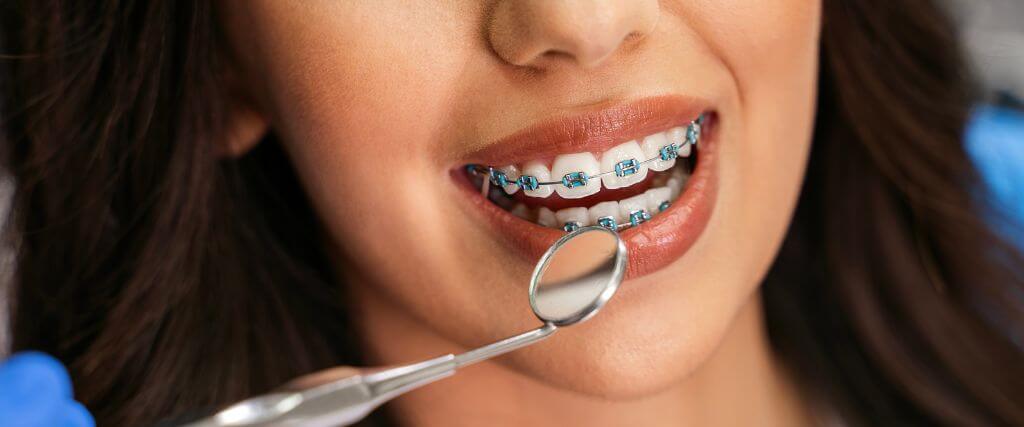Traditional metal braces have transformed countless smiles worldwide and remain one of the most effective and reliable orthodontic treatments available. As dental professionals, we recommend them to patients every day. This guide will walk you through everything you need to know about metal braces to help you determine whether they’re your best option for obtaining the perfect smile you desire.
How Traditional Braces Work
Metal braces use brackets, wires, and elastic bands to move teeth into ideal positions gradually. The brackets attach to your teeth with dental cement, and the archwire connects these brackets and applies consistent pressure to guide tooth movement. We carefully adjust these components during appointments to ensure proper alignment and bite correction.
Components of Traditional Braces
Traditional braces consist of multiple elements working together:
- Brackets: These small metal attachments bond directly to each tooth’s surface. Modern brackets feature a more streamlined design than their predecessors, making them more comfortable and less noticeable. The brackets anchor the other components and help control individual tooth movement throughout treatment.
- Archwires: These thin metal wires thread through the brackets and create the force necessary to move teeth. Your orthodontist will change these wires periodically, selecting different sizes and materials based on your treatment phase and specific needs.
.jpg)
Benefits of Choosing Traditional Braces
Traditional metal braces offer numerous benefits that make them a popular choice for many patients. Their strength and dependability guarantee effective results for a wide range of orthodontic challenges. Metal braces are particularly adept at addressing complex bite issues, severe crowding, and large gaps between teeth.
One of the key advantages of traditional braces is that they are fixed in place, which removes the compliance issues often associated with removable options. This characteristic is especially helpful for younger patients who may struggle to consistently wear aligners as directed.
The Treatment Process
Your orthodontic journey begins with a comprehensive consultation during which an orthodontist will examine your teeth, take dental X-rays, and create a customized treatment plan. The actual placement of braces typically takes one to two hours.
Monthly adjustment appointments allow your orthodontist to monitor progress and make necessary modifications. These visits typically last 20-30 minutes and are crucial in achieving optimal results.
Living with Traditional Braces
Maintaining good oral hygiene is even more important when you have braces. Regular brushing after meals and daily flossing help prevent decay and ensure the best possible outcome. Special tools like interdental brushes and water flossers can make cleaning around brackets easier.
Certain foods can damage braces or make cleaning more difficult. Hard candies, sticky foods, and ice may break brackets or bend wires. Cut crunchy fruits and vegetables into small bites, and avoid biting directly into foods like whole apples or corn on the cob.
Managing Discomfort
Many patients experience initial discomfort after getting braces and following adjustments, which typically subsides within a few days. Over-the-counter pain relievers and soft foods can help manage any temporary soreness. Dental wax provides relief from bracket irritation against the cheeks or lips.
Treatment Timeline
Typically, patients wear braces for about 18 to 24 months, but the exact duration can vary depending on individual circumstances.
Several factors can influence how long treatment takes, including:
- The severity of the orthodontic issues being addressed
- The patient’s age and overall oral health
- Adherence to care instructions and oral hygiene practices
- Consistent attendance at scheduled adjustment appointments
Emergency Care
While uncommon, orthodontic emergencies can occur. Loose brackets, poking wires, or lost elastic bands might require attention between regular appointments. Many minor issues have simple temporary solutions you can implement at home until you see your orthodontist.
Cost Considerations
Traditional braces often cost less than alternatives like clear aligners. Many dental insurance plans provide coverage for traditional braces, particularly for patients under 18. Some orthodontic practices offer payment plans or partner with lenders to make treatment more accessible.
+(1).jpg)
Results and Retention
Achieving straight teeth is only the beginning of your orthodontic journey. A retention plan helps maintain your new smile long-term. Your orthodontist will fit you with either removable or fixed retainers after removing your braces to help you keep your gorgeous smile.
Comparing Traditional Braces to Alternative Treatments
While clear aligners and ceramic braces provide more aesthetic options, traditional metal braces remain the most versatile treatment choice. They handle complex cases more predictably and often achieve results faster than alternative methods. And, as mentioned above, metal braces are the most cost-effective option.
Technology Advances
Today’s metal braces feature numerous technological improvements compared to their earlier counterparts. Heat-activated archwires provide more consistent force, while computer-aided treatment planning allows for more precise tooth movement predictions.
Long-Term Benefits
Beyond aesthetic improvements, properly aligned teeth contribute to better oral health. Straight teeth are easier to keep clean, minimizing the risk of tooth decay and gum disease. A corrected bite can also prevent excessive wear on teeth and help avoid jaw problems.
Making Your Decision
Choosing the right orthodontic treatment requires considering various factors.
Important things to consider include:
- Your treatment goals
- Lifestyle requirements
- Budget constraints
- Time commitment
Closing Thoughts
Traditional braces continue to set the standard in orthodontic care, offering predictable results for patients of all ages. Their versatility, reliability, and proven track record make them an excellent choice for achieving your ideal smile. Understanding what to expect helps you approach treatment with confidence and ensures the best possible outcome.
Successful orthodontic treatment relies on a partnership between you and your orthodontic team. Following care instructions, maintaining good oral hygiene, and attending regular appointments will help you achieve the beautiful, healthy smile you deserve.
If you think braces might be right for you or a loved one, don’t hesitate to schedule an appointment with an orthodontist. They will happily start you on the path to the healthy smile you’ve always wanted.

